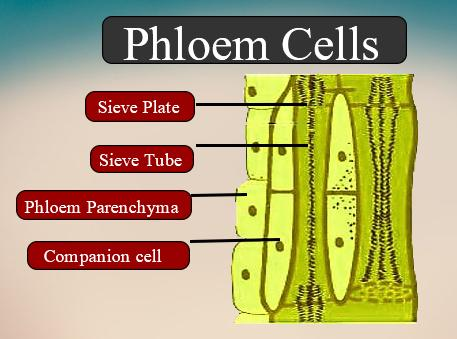
Phloem parenchyma is absent in
(a) Dicot roots
(b) Dicot leaf
(c) Monocot stem
(d) Dicot stem
Answer
494.7k+ views
Hint: Phloem parenchyma is composed of living parenchymatous cells. It stores food and organic materials and also helps in the transport of food material. These are absent in grass or grass-like plants whose seeds contain only one embryonic leaf.
Complete answer:
Phloem parenchyma are elongated cells that have tapering ends. They are cylindrical.
Phloem parenchyma is found in both primary and secondary phloem. It is a part of the phloem elements. These are found in dicot roots, leaves, and stems but are absent in monocot plants.
Additional Information: -Phloem is a living tissue that carries food materials, from the source to the sink. The phloem is made up of different elements. These are:
Sieve tube elements, phloem fibers, companion cells, and phloem parenchyma.
-Sieve tube elements are long thin-walled structures that lack nuclei in the mature state. These cells help in the food conduction.
-Companion cells are the specialized parenchymatous cells that are closely associated with sieve tube elements. They help in the maintenance of the pressure gradient in the sieve tube element.
Phloem fibers are the blast fibers that provide mechanical support.
-Phloem Parenchyma: These cells have dense cytoplasm and prominent nucleus. The cell walls are made up of cellulose and have pits. These elements store foods synthesized by the plants and also help to transport them to the various parts of the plants. These also contain organic materials like resins, tannins, mucilage, latex. These materials can be seen as an exudate.
So, the correct answer is, “Monocot stem.”
Note: -The pits present in the phloem parenchyma joins the adjacent cells to form a common connected wall. These form the plasmodesmata connection which is a microscopic channel through which the food and organic materials enter the Phloem.
-Xylem contains xylem parenchyma which is also a living tissue but is present in all vascular plants, unlike the phloem parenchyma.

Complete answer:
Phloem parenchyma are elongated cells that have tapering ends. They are cylindrical.
Phloem parenchyma is found in both primary and secondary phloem. It is a part of the phloem elements. These are found in dicot roots, leaves, and stems but are absent in monocot plants.
Additional Information: -Phloem is a living tissue that carries food materials, from the source to the sink. The phloem is made up of different elements. These are:
Sieve tube elements, phloem fibers, companion cells, and phloem parenchyma.
-Sieve tube elements are long thin-walled structures that lack nuclei in the mature state. These cells help in the food conduction.
-Companion cells are the specialized parenchymatous cells that are closely associated with sieve tube elements. They help in the maintenance of the pressure gradient in the sieve tube element.
Phloem fibers are the blast fibers that provide mechanical support.
-Phloem Parenchyma: These cells have dense cytoplasm and prominent nucleus. The cell walls are made up of cellulose and have pits. These elements store foods synthesized by the plants and also help to transport them to the various parts of the plants. These also contain organic materials like resins, tannins, mucilage, latex. These materials can be seen as an exudate.
So, the correct answer is, “Monocot stem.”
Note: -The pits present in the phloem parenchyma joins the adjacent cells to form a common connected wall. These form the plasmodesmata connection which is a microscopic channel through which the food and organic materials enter the Phloem.
-Xylem contains xylem parenchyma which is also a living tissue but is present in all vascular plants, unlike the phloem parenchyma.

Recently Updated Pages
Master Class 9 General Knowledge: Engaging Questions & Answers for Success

Master Class 9 English: Engaging Questions & Answers for Success

Master Class 9 Science: Engaging Questions & Answers for Success

Master Class 9 Social Science: Engaging Questions & Answers for Success

Master Class 9 Maths: Engaging Questions & Answers for Success

Class 9 Question and Answer - Your Ultimate Solutions Guide

Trending doubts
What are Quantum numbers Explain the quantum number class 11 chemistry CBSE

Who built the Grand Trunk Road AChandragupta Maurya class 11 social science CBSE

1 Quintal is equal to a 110 kg b 10 kg c 100kg d 1000 class 11 physics CBSE

The reason why India adopted the policy of nonalignment class 11 social science CBSE

The plastids which are coloured green and colourless class 11 biology CBSE

Earth rotates in which direction A East to west B West class 11 physics CBSE




